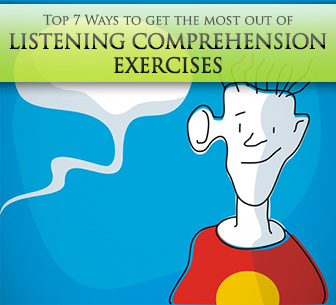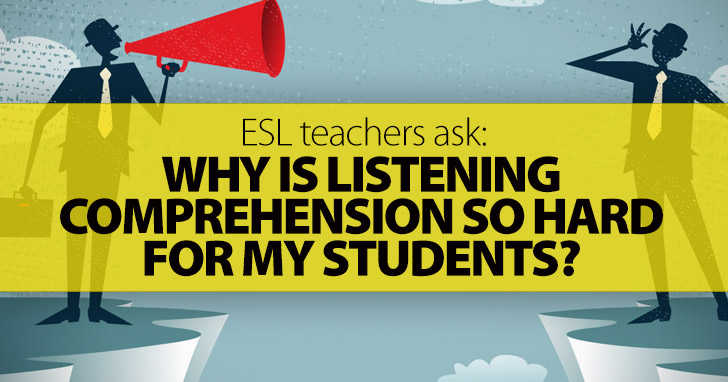Top 7 Ways to Get the Most out of Listening Comprehension Exercises


“I have a particular group of ESL students, whose weak point seems to be listening comprehension. I have to play the audio recording several times before they’re able to answer any questions. Why is listening comprehension so hard for them?” *
Listening comprehension is one of those skills that you simply can’t put your finger on. It seems to be easy enough for some. For others, it’s a nightmare. Why is this so?
A number of factors contribute to the extent to which an ESL student is able to understand an audio recording in English. Some of these factors may be characteristics we can attribute to the students themselves, things like working memory, anxiety or mental blocks. Other factors deal with characteristics of the audio track, things like length and complexity. Finally, others are specifically related to the task at hand, things like time pressure and note taking. But to answer the question, let’s address some specific reasons your ESL students are having such a hard time with their listening tasks.

Most students with listening comprehension issues get stuck trying to understand every single word. They try to figure out the meaning of just one word, and before they know it, the recording is finished, and they’ve missed most of it.
 Tip: Be sure to tell students that the goal of the listening task is not for them to understand each and every word. Present the goal clearly and make sure students understand what they are expected to do. If the goal is for them to listen and complete a chart with information, like for example a travel itinerary, they must listen for the specific words and phrases that give them the information they need. If the goal is for them to get the gist, they will most likely get it even if they miss a word or two in the middle.
Tip: Be sure to tell students that the goal of the listening task is not for them to understand each and every word. Present the goal clearly and make sure students understand what they are expected to do. If the goal is for them to listen and complete a chart with information, like for example a travel itinerary, they must listen for the specific words and phrases that give them the information they need. If the goal is for them to get the gist, they will most likely get it even if they miss a word or two in the middle.
One new word will probably not affect your students’ ability to comprehend an audio track, but what if there are several words they don’t know? You must also consider if there are any words that are essential to their comprehension, as when two people are talking about a new food to try, or a sport, or a recently developed technology.
 Tip: There are cases in which it is absolutely necessary for you to teach new vocabulary before the listening task. This is helpful so they can not only learn new words, but also be better prepared to comprehend the listening. Be sure to check the audio track, if possible read the audio script, and make a list of words your students may need to know.
Tip: There are cases in which it is absolutely necessary for you to teach new vocabulary before the listening task. This is helpful so they can not only learn new words, but also be better prepared to comprehend the listening. Be sure to check the audio track, if possible read the audio script, and make a list of words your students may need to know.
Some students say that as they’ve mostly been exposed to American English, they don’t understand the British English accent, or vice versa. A whole other problem is when they don’t understand certain foreign accents, i.e. an Italian/French/Korean person speaking English.
 Tip: Depending on the class, you could choose one of two paths. You could focus on the accent they need to grasp. I would recommend this, for example, if you have a group preparing to sit for any of the Cambridge ESOL exams. Most of the audio features British English, and your students need to train their ears for this particular accent because their exam score depends on it.
Tip: Depending on the class, you could choose one of two paths. You could focus on the accent they need to grasp. I would recommend this, for example, if you have a group preparing to sit for any of the Cambridge ESOL exams. Most of the audio features British English, and your students need to train their ears for this particular accent because their exam score depends on it.
The second route is to give them as much variety as possible. In real life, students will encounter people from a variety of backgrounds, and they’ll need a great deal of flexibility if they want to interact or do business with people from all over the world.
It all starts rather well, and your students remember what was said at the beginning of the audio track. But then their attention fizzles out, and they get lost.
 Tip: This is something that typically occurs when the audio track is too long. If you want to run a marathon, first you try running 1K, then 5K, then 10K and so on. The same thing happens with listening. It’s a skill that has to be honed over time and must start with short listening tasks. This does not mean you can’t give your class a longer conversation to listen to. Simply break it down into parts.
Tip: This is something that typically occurs when the audio track is too long. If you want to run a marathon, first you try running 1K, then 5K, then 10K and so on. The same thing happens with listening. It’s a skill that has to be honed over time and must start with short listening tasks. This does not mean you can’t give your class a longer conversation to listen to. Simply break it down into parts.
Your students understand you just fine when you’re speaking to them, and they can work very well with videos. But they have a really hard time listening to an audio track. Listening on the telephone, for example, is nothing short of torture.
 Tip: When it comes to learning, some students are more visual. They need to see. Whether it is illustrations or facial gestures, they are lost without the visual component. Naturally, you can give them listening tasks with video, but you’ll want to gradually wean them out of it so they rely less on the visual input (they’ll need this skill for telephone speaking). Watch a video once, then cover the TV/computer screen and have them listen with no picture. Or have them watch some parts and listen to some parts with audio only. For audio tracks, have them read the audio script as they listen. Then, try a second listening without the script. Try different types of tasks with longer or shorter tracks. Just be sure to give them something they can read or see for at least some of the tasks. Eventually, they should notice a change and should be able to handle some listening with no visual cues.
Tip: When it comes to learning, some students are more visual. They need to see. Whether it is illustrations or facial gestures, they are lost without the visual component. Naturally, you can give them listening tasks with video, but you’ll want to gradually wean them out of it so they rely less on the visual input (they’ll need this skill for telephone speaking). Watch a video once, then cover the TV/computer screen and have them listen with no picture. Or have them watch some parts and listen to some parts with audio only. For audio tracks, have them read the audio script as they listen. Then, try a second listening without the script. Try different types of tasks with longer or shorter tracks. Just be sure to give them something they can read or see for at least some of the tasks. Eventually, they should notice a change and should be able to handle some listening with no visual cues.
Then, it’s all about implementing the right strategies. And putting in the hard work. For the more they listen, the more they will notice improvement.
* This question was sent in from a real ESL teacher, just like you! If you need any advice on a particular topic, share your question in the comments below. Or tweet your question to @busyteacher_org with the hashtag #ESLTeachersAsk. Your question might get picked and featured in an article!